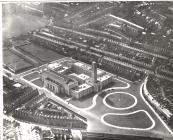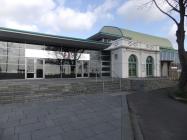Victoria Park and the Guildhall, Swansea
Items in this story:
Victoria Park and the Guildhall, Swansea
Victoria Park, one of Swansea’s most impressive public parks, was unveiled on Jubilee Day, 1887. The compact nature of the park and its formal gardens today masks a much larger site that survived until the construction of the Guildhall in the 1930s. For many late-19th and early-20th century soccer and rugby teams, the numerous playing fields on the western portion of Victoria Park provided a home ground. For much of the 1890s, Victoria Park was a relatively simple location with few of the attributes that are commonly associated with larger 19th century public parks such as rose gardens, tree-lined walkways, and bandstands. These would be laid out in the course of the Edwardian period and by the outbreak of the Great War in 1914, the site had been transformed.
Edwardian Fixtures
The first of the Edwardian fixtures to be unveiled was the bandstand which opened on 14 May 1903 and was situated overlooking Oystermouth Bay near the centre of the original park. Early plans for a bandstand dated from 1888 but these remained largely unfulfilled because of disagreements about the design: there was a belief amongst some of Swansea’s councillors that Victoria Park should have a different design compared to the bandstand at Cwmdonkin Park.
Statue of William Thomas
The famous statue of William Thomas, the ‘champion of open spaces’, which occupied a prominent position in the twenty-first century Victoria Park, was erected in 1906 and a tree-lined walkway through the park joining Francis Street to Oystermouth Road had been laid out. At the main entrance, which today serves as the entrance into the Guildhall, were elaborate iron railings and the memorial to the South African War. Unveiled on 15th April 1904 by the Mayor of Swansea, Griffith Thomas, the monument had cost £500 to construct and was paid for by public subscription. When the Guildhall was constructed and the eastern half of Victoria Park lost, this statue was transferred to its present site overlooking Oystermouth Bay.
Patti Pavillion
Dominating the modern Victoria Park is this building, the Patti Pavilion, which was once the winter garden of the famous nineteenth-century Opera Soprano, Dame Adelina Patti, at her Craig-y-Nos estate in the upper Swansea Valley. Given her close association with Swansea and the surrounding area, Dame Patti decided to bequeath the winter garden to the town upon her death (in 1919). The building was re-erected in its present position in 1920 and became known as the Patti Pavilion.
The Guildhall
The construction of the Guildhall, which was officially opened on 23 October 1934 by Prince Albert, Duke of Kent (later King George VI), began in 1930 on the eastern part of Victoria Park as the fulfilment of Swansea County Borough Council’s wish to have a more impressive statement of the town’s civic identity than the original council buildings in the docklands (now the Dylan Thomas Centre). The site at Victoria Park was chosen in part because of the view but primarily because the council owned the land and would not therefore have to negotiate with private landowners. With a budget of £300,000 and a design by Percy Thomas, a Cardiff architect, the new civic identity of Swansea was being given material form.
Architecturally, the Guildhall exemplifies the simple grace and beauty of modernism with a handful of embellishments to identify the building with Swansea. In particular: the landmark clock tower, which was designed to give the impression of a Viking longboat and is a nod to Sweyn Forkbeard and Swansea’s Viking origins.
Victoria Park in the 21st century
Victoria Park in the twenty-first century remains in active use. Modern sporting facilities provide for basketball, BMX, and skateboarding, as well as more traditional sports such as tennis and bowls. The recently opened western extension to the Patti Pavilion houses an Indian Restaurant and concert hall. And, in keeping with the park’s Victorian heritage, the formal flower beds and floral clock continue to draw visitors into the heart of Swansea’s seaside civic quarter.
Daryl Leeworthy, RCAHMW.





